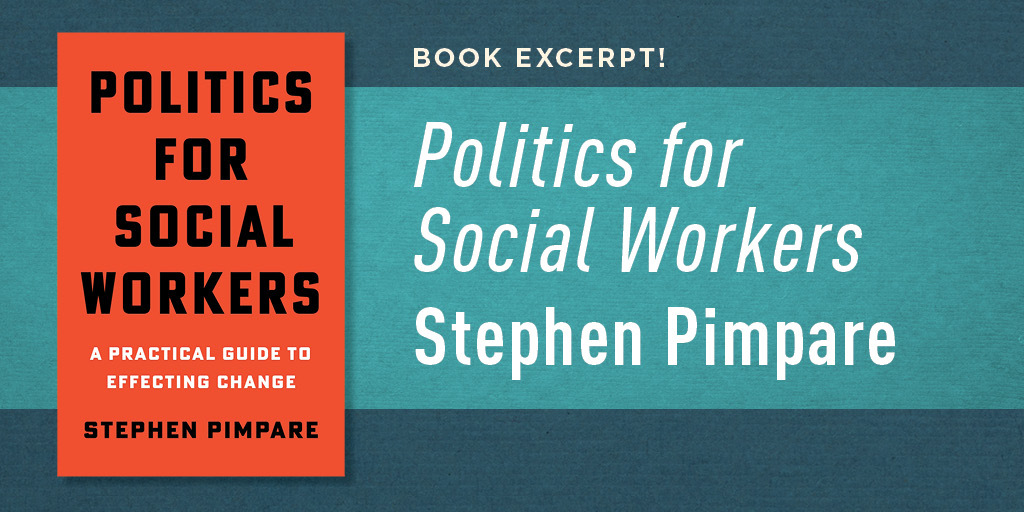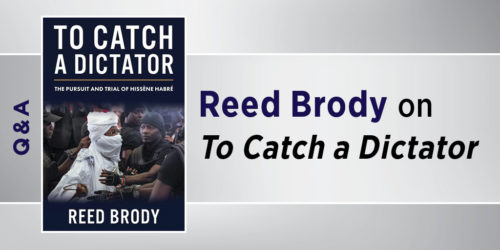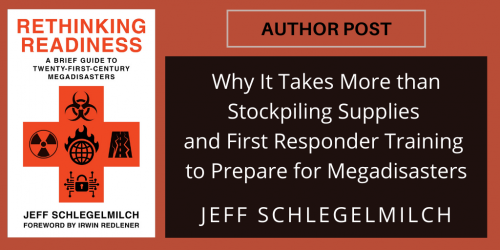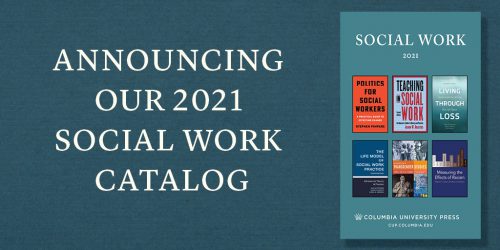Book Excerpt! Politics for Social Workers By Stephen Pimpare

Policy historians write about the two “big bangs” of U.S. welfare state development—the New Deal programs of the 1930s and the Great Society programs of the 1960s. You might encounter others describing these moments as “critical junctures.”
Could March 2020 and the onset of the Covid-19 pandemic have marked the beginning of a third big bang? Did we enter another critical juncture in our political and policy history?
In that month alone, so much of what for years we had been told could not be done was done almost overnight. Congress enacted a national paid sick leave policy (albeit a temporary one), ending our status as the only rich democracy without one. They instituted a national emergency unemployment insurance program to supplement the state-run plans, and a relatively generous one at that, sending an additional $600 per week to people who could not work (and expanding the definition of who was eligible), then extending it at $300 per week at the end of the year. They suspended student loan payments for six months (and later extended that for an even longer period) and authorized the federal government to send a cash payment of up to $1,200 per adult and $500 per child to almost every family in the country (subsequently doing it again at half the amount). These initiatives were bold enough that household income actually rose and poverty rates declined even though the most comprehensive official unemployment measure exceeded 20 percent at one point that year. And even if it was short-lived, many of Washington’s reliable deficit hawks (people who worry a lot about the size of federal deficits, or pretend that they do) recognized the urgent need for action and debt-financed spending.
Farm workers and meat processing plant employees, many of whom were undocumented, continued to feed the nation while being ineligible for any of the expanded relief programs.
Meanwhile, states eased eligibility for their own unemployment programs, suspended work requirements for Medicaid and the Supplemental Nutrition Assistance Program (SNAP, what we used to call Food Stamps), expanded SNAP eligibility and increased benefit levels, created emergency funds to support day-care facilities, opened up new shelter spaces for people who were experiencing homelessness, and released people who had been incarcerated for trivial offenses or who had served a significant percentage of their sentence. Nonviolent offenders were issued warnings instead of being arrested. Governments encouraged (or required) localities to suspend evictions and eliminate penalties for late property tax payments, directed public utilities not to cut off water or power for people who fell behind on their bills, and advised local authorities to equip the local camps set up by homeless people with portable bathrooms and washing stations. Many cities reconfigured their public spaces, making more of it closed to cars and available to pedestrians, cyclists, diners, and children at play.
Businesses raised workers’ wages (although making sure to note that such increases were temporary), while people started to earnestly thank grocery store clerks, delivery people, and health care workers for their service just as they had previously done for veterans of the U.S. armed forces. In some cities, homeless people claimed and occupied vacant, abandoned properties that were owned by the city. A smattering of strikes by front-line service and delivery workers spread throughout the country, causing still more businesses to raise wages, provide protective equipment, and promise safer working conditions. And in what may be one of the greatest acts of mass solidarity of the era, untold millions of us remained sequestered in our homes in order to stop the spread of the disease and protect our neighbors from illness or death.
To be sure, even this crisis was not enough to get Congress to enact the more radical proposals that were before them in those early months—a permanent national unemployment insurance program guaranteeing that people receive 100 percent of their former wages, abolition of student loan debt, a nationwide rent and mortgage moratorium, expanded access to Medicaid and Medicare, or stricter occupational health and safety regulations for the most at-risk occupations. Farm workers and meat processing plant employees, many of whom were undocumented, continued to feed the nation while being ineligible for any of the expanded relief programs. Immigration and Customs Enforcement (ICE) continued to capture and imprison immigrants and refugees (kidnapping and then losing track of their children in the process), and, even with state, county, and municipal action, by mid-year the Covid-19 death rate for prisoners was 5.5 times higher than the overall rate. By May of 2020 that sense of urgency and solidarity seemed to have left Washington, D.C., even though more than 100,000 people had already been officially counted among the dead at that point.
As has historically been the case, much of the violence that occurred was instigated by agents of the state, not those protesting the aggressively racist practices of its institutions.
But then yet another Black man was killed by the police—his name was George Floyd this time—and a massive wave of sustained protest swept through the nation, inspiring comparisons to the “unrest” of the 1960s and generating concern that the U.S. was slipping into irredeemable chaos. As has historically been the case, much of the violence that occurred was instigated by agents of the state, not those protesting the aggressively racist practices of its institutions. And in response to those events, states and localities started what in some cases were serious conversations about reducing the portion of their budgets allocated to police forces (as “Defund the Police” became a rallying cry). Citizens toppled statues and defaced monuments erected to the Confederacy, and many finally came to recognize the Confederate Battle Flag as an inherently racist symbol; NASCAR and the U.S. Navy even banned its display. These were the largest, sustained mass protests the U.S. had seen since the peak of the Black rights movements of the 1960s, and perhaps the largest in our history—another extraordinary instance of mass solidarity.
As is common during crises, bad actors will seize such moments to enact their preferred policy changes. The Trump Administration used the pandemic, economic crisis, and outrage over racist state violence as cover for rolling back environmental protections, accelerating anti-immigrant policies and border closures, firing oversight officials perceived as hostile to their autocratic impulses or impeding their efforts to profit from the crisis, continuing efforts to corrupt the decennial Census count, delegitimizing absentee voting methods and undermining the 2020 election, and engaging in increasingly aggressive extra-Constitutional efforts to suppress speech and assault protesters, culminating in the deployment of armed federal troops to stir unrest in Democratic cities and voicing support for right-wing terrorists who murdered protesters. Many worried about rising authoritarianism and “democratic backsliding,” concerns that attained new weight as Trump waged a sustained coup effort after having lost to President Biden. And while his defeat ratcheted down the immediate threat, the risk remains.
The accreditation standards for schools of social work require that students not only understand the federal and state social welfare policies that affect their clients, but that they engage in “policy practice.” The National Association of Social Workers (NASW) Code of Ethics similarly obligates practitioners to “engage in social and political action,” “advocate for changes in policy” that benefit vulnerable populations, and “promote social justice.” But how can a busy LCSW with a full caseload make time for activism? What lessons can social workers and others working with and for marginalized populations take away from this extended series of crises that will help them advocate for and enact policies to improve the well-being of the people and places they care about?
Stephen Pimpare is director of the Public Service and Nonprofit Leadership Program at the University of New Hampshire. He is the author of Politics for Social Workers: A Practical Guide to Effecting Change.








